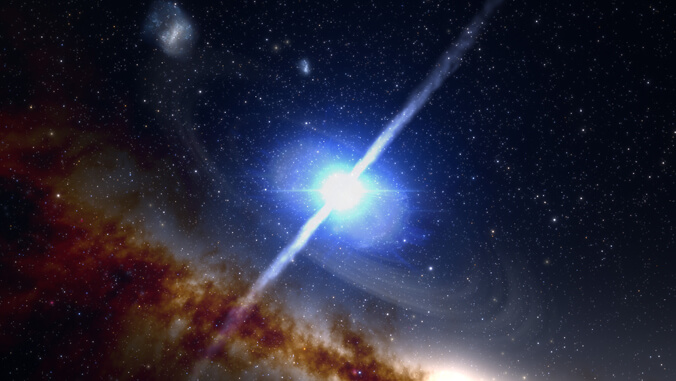Maunakea Telescopes Help Uncover Source Of Puzzling Gamma-Ray Bursts
Mysteries surrounding the origins of castaway gamma-ray bursts or flashes of intense energy may be unlocked thanks to data collected from some of the most powerful telescopes on Earth including two observatories on Maunakea
 Image credit: NOIRLab/NSF/AURA/J. da Silva/Spaceengine An international team of astronomers has found that certain short gamma-ray bursts (GRBs) did not originate as castaways in the vastness of intergalactic space as they initially appeared. A deeper multi-observatory study instead found that these seemingly isolated GRBs actually occurred in remarkably distant—and therefore faint—galaxies up to 10 billion light-years away.
Image credit: NOIRLab/NSF/AURA/J. da Silva/Spaceengine An international team of astronomers has found that certain short gamma-ray bursts (GRBs) did not originate as castaways in the vastness of intergalactic space as they initially appeared. A deeper multi-observatory study instead found that these seemingly isolated GRBs actually occurred in remarkably distant—and therefore faint—galaxies up to 10 billion light-years away.
Observations were conducted from a number of telescopes, including W. M. Keck Observatory and Gemini North on Maunakea. This discovery suggests that short GRBs, which form during the collisions of neutron stars, may have been more common in the past than expected. Since neutron-star mergers forge heavy elements, including gold and platinum, the universe may have been seeded with precious metals earlier than expected. The study has been accepted for publication in the Monthly Notices of the Royal Astronomical Society.
“Many aspects of GRBs remain a mystery, but thanks to the power of telescopes on Maunakea and their ability to reveal very faint, distant galaxies, we are continuing to learn about the immensely powerful explosions,” said John O’Meara, Chief Scientist at Keck. “I look forward to seeing what we can learn next as the work continues.”
“Many short GRBs are found in bright galaxies relatively close to us, but some of them appear to have no corresponding galactic home,” said Brendan O’Connor, lead author and astronomer at University of Maryland and George Washington University. “By pinpointing where the short GRBs originate, we were able to comb through troves of data from multiple observatories to find the faint glow of galaxies that were simply too distant to be recognized before.”
Going forward
This result could help astronomers better understand the chemical evolution of the universe. Merging neutron stars trigger a cascading series of nuclear reactions that are necessary to produce heavy metals, such as gold, platinum and thorium. Pushing back the cosmic timescale on neutron-star mergers means that the young universe was far richer in heavy elements than previously known.
Publication: B. O'Connor, et al. A deep survey of short GRB host galaxies over z∼0−2: implications for offsets, redshifts, and environments. Monthly Notices of the Royal Astronomical Society, (2023). DOI: 10.48550/arXiv.2204.09059
Original Story Source: University of Hawaii at Manoa

 Alerts Sign-up
Alerts Sign-up